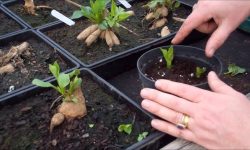Introduction
Sunflowers are one of the most iconic and cheerful flowers in the gardening world. Known for their large, vibrant blooms that follow the sun, these plants are surprisingly easy to grow from seeds. Whether you’re looking to create a stunning summer display, attract pollinators, or harvest seeds for snacks and bird feed, growing sunflowers from seeds is a gratifying experience. This guide will walk you through every step of the process, from selecting seeds to nurturing towering blooms.
Why Grow Sunflowers from Seeds?

Starting sunflowers from seeds allows gardeners to enjoy a broader variety of colors, sizes, and types. It is more cost-effective than buying young plants and gives you full control over the growing process. Additionally, watching your sunflowers develop from seed to bloom provides a rewarding sense of accomplishment, especially for new gardeners or children learning about plant life cycles.
Choosing the Right Sunflower Variety
Sunflowers come in a wide range of varieties, from giant single-headed types that can reach up to 12 feet tall to smaller, bushier versions ideal for containers and borders. When selecting seeds, consider your space, climate, and the purpose of your sunflowers. Tall varieties like ‘Mammoth’ are perfect for dramatic garden backdrops, while dwarf types like ‘Teddy Bear’ are better suited for patios and window boxes.
When to Plant Sunflower Seeds
Timing is crucial when planting sunflower seeds. Sunflowers are warm-weather plants and need soil temperatures of at least 50 to 60°F (10 to 16°C) to germinate effectively. Most gardeners plant sunflowers in the late spring, after the danger of frost has passed. In cooler climates, you can start seeds indoors about two weeks before the last expected frost date to get a head start.
Preparing the Planting Area
Sunflowers thrive in full sunlight and well-drained soil. Choose a planting site that receives at least six to eight hours of direct sunlight per day. Prepare the soil by loosening it to a depth of about two feet, especially for tall varieties that develop deep roots. Enrich the soil with compost or organic matter to provide nutrients and improve drainage. If planting multiple sunflowers, ensure the site has enough space for air circulation and growth.
How to Sow Sunflower Seeds
To sow sunflower seeds directly into the ground, dig small holes about 1 to 2 inches deep. Drop one seed into each hole and cover it with soil. Gently pat the surface to secure the seed and water thoroughly. If starting indoors, use biodegradable pots filled with seed-starting mix. Place one seed per pot and keep the soil consistently moist until germination occurs.
Germination and Early Care
Sunflower seeds typically germinate within 7 to 10 days under optimal conditions. Once the seedlings emerge, thin them out by removing the weaker ones, allowing the strongest to continue growing. If you started your seeds indoors, transplant them outdoors once they have developed a few sets of true leaves and the risk of frost has passed.
When transplanting, be gentle with the roots, especially if using pots that need to be removed. Water the plants immediately after transplanting to help them establish in their new location.
Sunflower Growth Stages
Sunflowers go through several growth stages before reaching maturity. After germination, the plant enters the vegetative stage, during which it develops leaves and a thick stem. Next comes the budding stage, where a flower bud forms at the top. The blooming stage follows, lasting several weeks, during which the flower opens and follows the sun throughout the day. Finally, the plant enters the seed development stage if pollination has occurred.
Watering and Feeding Sunflowers
Although sunflowers are somewhat drought-tolerant once established, they require consistent watering during early growth and flowering. Water deeply once or twice a week, depending on rainfall and temperature, to encourage deep root development. Avoid overwatering, as soggy soil can lead to root rot.
Fertilizing sunflowers is generally not necessary if the soil is already rich. However, if growth appears slow or leaves are pale, applying a balanced, slow-release fertilizer can give the plants a boost. Avoid fertilizers high in nitrogen, which can promote leafy growth at the expense of flowers.
Staking and Support
Tall sunflower varieties may need support to prevent them from toppling over in wind or heavy rain. Install stakes at planting time or when the plants reach about two feet tall. Tie the stems loosely to the stakes using soft plant ties or fabric strips. In windy areas, planting sunflowers along a fence or wall can also provide natural support.
Common Pests and Diseases
Sunflowers are generally hardy, but they can be affected by pests such as aphids, caterpillars, and sunflower beetles. Inspect the plants regularly, especially the undersides of leaves, and remove pests by hand or use insecticidal soap if necessary.
Fungal diseases like powdery mildew or rust can appear in humid conditions. To prevent these issues, ensure proper spacing for air circulation, avoid overhead watering, and remove any infected leaves immediately. Crop rotation can also help reduce disease buildup in the soil.
Harvesting Sunflower Seeds
If you plan to harvest sunflower seeds, allow the flower heads to fully mature on the plant. The back of the flower head will turn yellow or brown, and the seeds will look plump and black with white stripes, depending on the variety. Cut the head off the plant with a few inches of stem attached and hang it upside down in a dry, well-ventilated area.
Once fully dry, rub the seeds out by hand or use a stiff brush. Clean them by removing debris and store them in a sealed container. Sunflower seeds can be roasted for snacks, saved for replanting, or used as bird feed.
Saving Seeds for the Next Season
Saving seeds is a simple way to enjoy sunflowers year after year. Choose the best-looking flowers and allow them to go to seed. Harvest the seeds as described above and store them in a cool, dry place. Label each batch with the variety and date collected to ensure freshness.
Companion Planting with Sunflowers
Sunflowers are excellent companion plants. They attract pollinators and beneficial insects, provide shade to heat-sensitive crops, and can even act as natural trellises for climbing beans or cucumbers. However, be mindful of their size and potential for shading smaller plants. Also, sunflowers release allelopathic chemicals that can inhibit the growth of certain plants, so avoid planting them near potatoes or beans if possible.
FAQ About Growing Sunflowers from Seeds
What is the best time to plant sunflower seeds?
The best time to plant sunflower seeds is in the spring, after the last frost has passed and the soil temperature has reached at least 55°F (13°C). This timing ensures optimal germination and growth.
How long do sunflower seeds take to germinate?
Sunflower seeds typically germinate within 7 to 10 days, depending on the soil temperature and moisture levels. Warmer conditions may speed up germination.
Can sunflowers grow in pots or containers?
Yes, dwarf sunflower varieties are ideal for pots and containers. Choose a large container with good drainage and ensure it receives full sunlight throughout the day.
How much sunlight do sunflowers need each day?
Sunflowers thrive in full sun and need at least 6 to 8 hours of direct sunlight daily. More sunlight usually results in taller plants and larger blooms.
Do sunflowers need a lot of water?
Sunflowers need regular watering during germination and early growth. Once established, they are relatively drought-tolerant but will perform best with consistent moisture, especially during flowering and seed development.
Conclusion
Growing sunflowers from seeds is a joyful and fulfilling gardening project. With their bright faces and towering stems, sunflowers add a sense of wonder to any garden space. By choosing the right variety, preparing the soil, and giving your plants the care they need, you can enjoy healthy blooms all summer long. Whether you’re growing them for beauty, seeds, or to support pollinators, sunflowers are a reliable and rewarding choice for gardeners of all levels.






